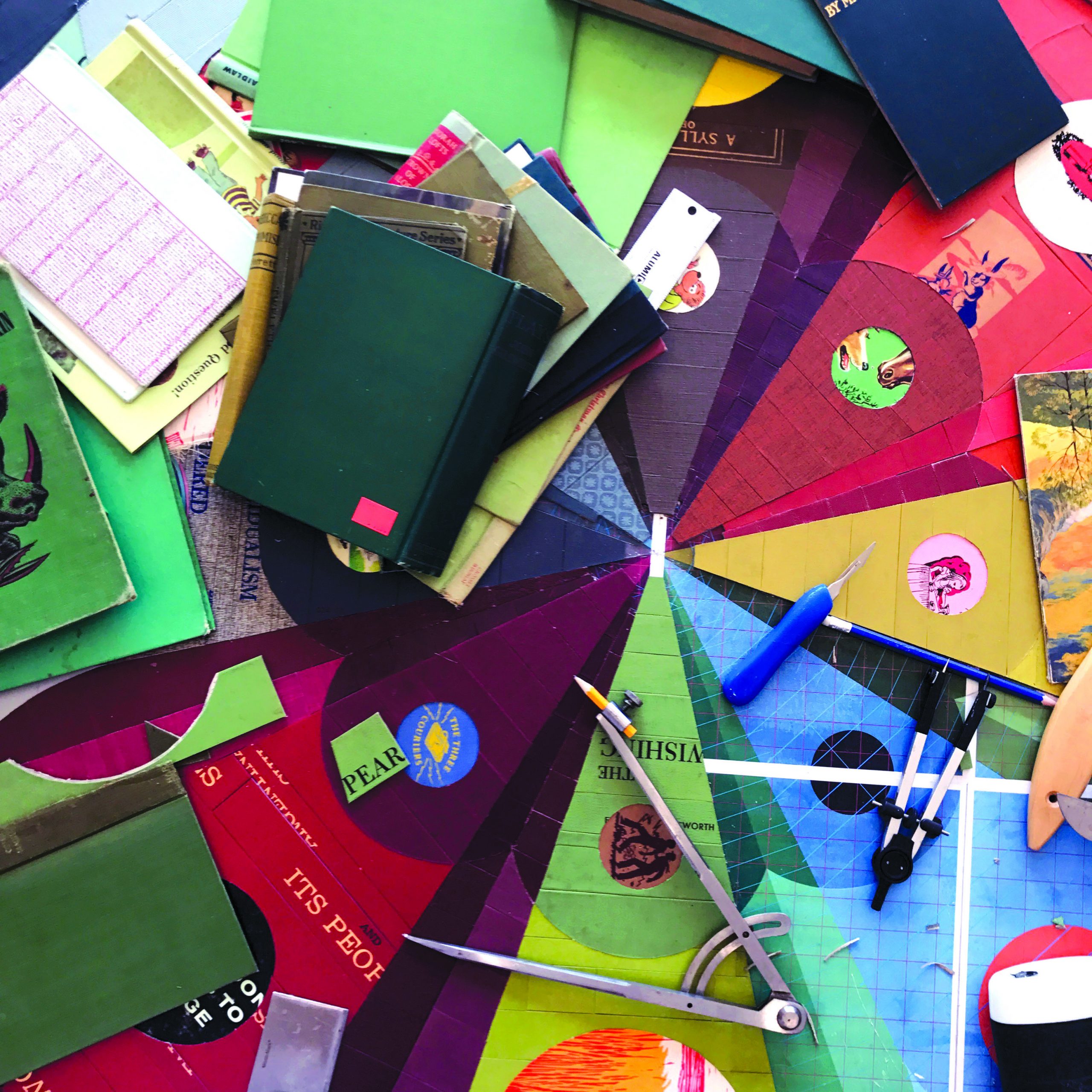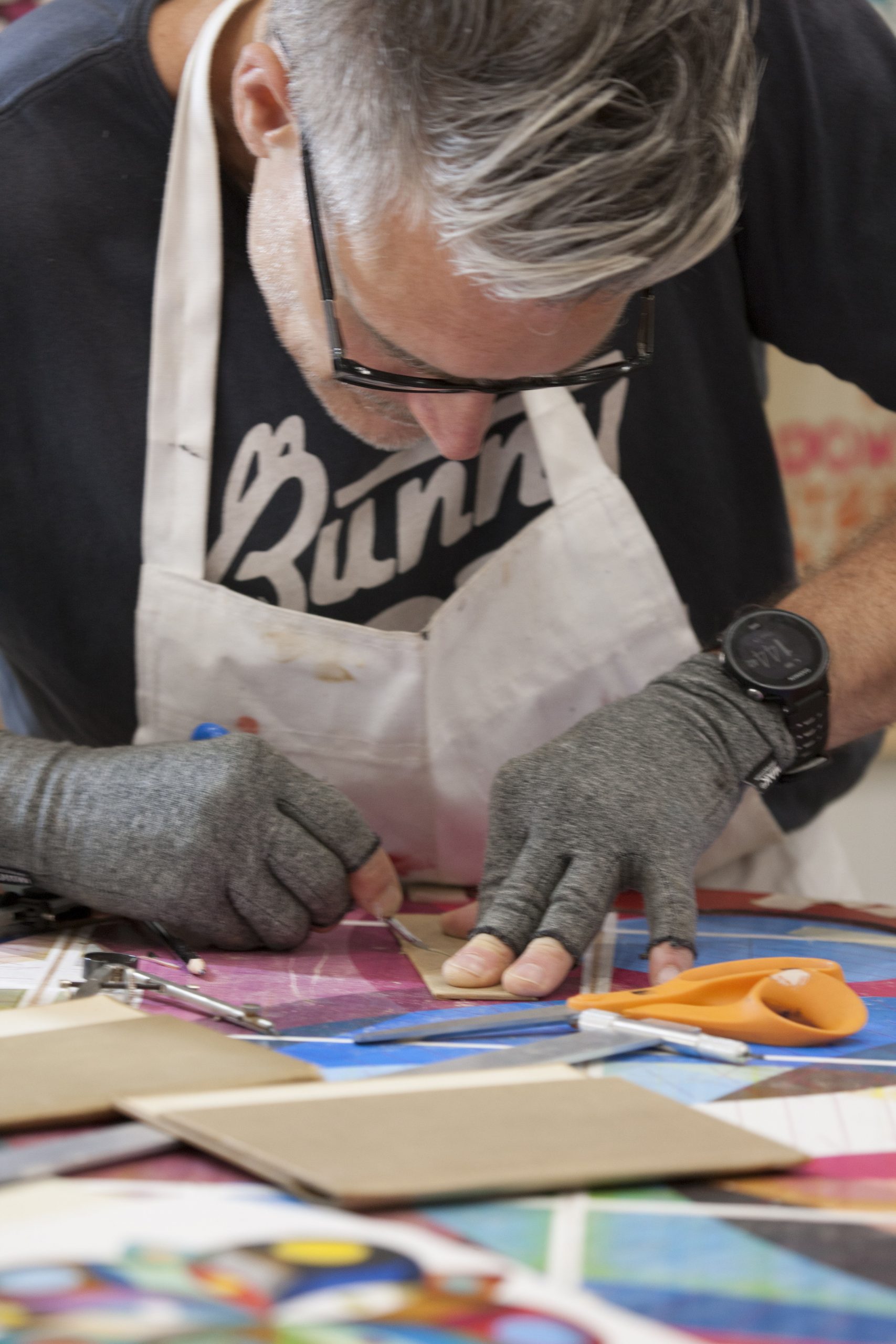Neil Powell Turns Discarded Book Covers Into Art
A million old books are destroyed each day in America. Neil Powell gives a portion of them new life.
Neil Powell has quite literally made a living off judging books by their covers.
To be more specific, the 52-year-old artist, currently riding out the coronavirus-mandated quarantine while at home in the Catskills, repurposes discarded, torn and damaged book covers into pieces of art.
Take his 48x48x3 piece titled “Us:” Powell creates a rendition of the flag of the United States by amalgamating a variety of book covers — blue, white and red ones, predominantly — and plastering them on pieces of wood. To create the 48x48x2 “Space Cadet — “a piece in the shape of a missile — Powell opts for a vaster array of colors, also utilizing the typography on some covers to spell out “get your ass to Mars.”
Eclectic and visually striking, Powell’s works lend themselves to the kinds of grandiose hotel and arena spaces that his clients, primarily interior designers, are hired to outfit. Needless to say, the entities can also easily afford the $2,500-to-$10,000 price tag associated with the one-of-a-kind pieces.

The artist’s fascination with books seems to be almost inevitable: his mother is an English professor and, alongside his father, spent years collecting antique objects, including those of a literary kind. Add to that Powell’s deep-rooted fascination with art — an initial foray into mechanical engineering at the University of Kentucky turned into a Bachelor of Fine Arts in graphic design and painting which then turned into a full-time career in art a mere six years ago — and the root of his mode of expression becomes obviously clear.
“As a young designer I found myself collecting old children’s books just because they were letterpress or foil stamped or had interesting illustrations and production techniques that you don’t really see anymore,” he says.
That passion for texture is still what drives his search for the ideal tome. “I don’t like paper covers,” he explains. “I don’t [use] books produced after approximately 1980 because they then started getting rid of the fabric covers and replacing them with folded paper ones.”

To find materials, Powell used to regularly visit the $1 racks at New York City’s famous Strand Bookstore, until he realized that, given the amounts of books needed to complete each project, he’d have to cut his budget. He has since developed relationships with libraries that call him when looking to get rid of products and he also attends estate sales. “There are usually these really amazing books from the 1920s and 1930s that are second and third editions that nobody wants and are kind of falling apart anyway,” he explains. “So I can swoop in and buy up to 100 or 200 books for $25.”
He organizes his finds by color, which seems to be the driving force behind his selection of books when in the throes of building a new piece. He himself describes his process as “very nonlinear” and strictly unrelated to the contents of the actual books.
However, although he doesn’t make use of the guts of each literary treasure (which, some argue, might actually be the essence of a book) but actually recycles them, Powell fully appreciates the historical context of each tome — not necessarily given the words written inside but as actual objects that have lived through time and space. “I’m dealing with these things that have gone through people’s hands for decades,” he says. “Some of them have sat on people’s desks for 50 years and […] and that element of time is always present in my process.”
A callout to time and reflection is what he also mentions as the unifying message across his canon of work. “It’s about self-identity and how we fit into this world and the struggles that we have as individuals,” he explains. There are, however, undoubtedly less subtle messages that the artist actually spells out in his work by using letters, words and sentences from each cover and displaying them out of context.
The artist isn’t surprised to be prompted about his feelings towards, in a way, perverting the message of a book by disembodying the text from its shell and subsequently re-arranging said shell. “The thing that most people don’t realize is that we destroy over a million books a day in this country,” he explains. “We’ve been printing hundreds of millions of books for decades so we have these huge depositories of old books. The only value they have is to look cool on your shelf.” What better way to imbue them with new life than repurposing at least portions of them?

The creativity that has allowed him to settle on a unique aesthetic is the sort of attribute that Powell hopes to see more of in the art world given the slump that the industry is currently in. “It’s usually times like these when great art was made,” he says. “It could be a really exciting time creatively because we’re going to have to find new ways to communicate and sell art.”
For his part, Powell is looking to step away from his studio in Gowanus, Brooklyn and move to the Catskills permanently, hoping to, for the time being, mount outdoor exhibitions that will attract folks unable to gather inside galleries and museums.
As for his favorite book (to read, that is), Powell is partial to Ayn Rand’s literary masterpiece The Fountainhead. “Set aside the political stuff in there,” he says. “What speaks to me is this person who wants to do something different and no one understands what he’s talking about.” Clearly reminded of his own journey, Powell continues: “It took me a while to find that place. You want to give up on the way, but you have to believe in it more than anyone else.”

